Samsung Leader 8: A Comprehensive Marketing Plan Review
VerifiedAdded on 2020/04/01
|13
|2759
|1203
AI Summary
The document provides an overview of a comprehensive marketing strategy for Samsung’s new product, the Leader 8. It includes insights into various aspects such as target markets, competitive analysis through SWOT, strategic positioning, promotional tactics, distribution channels, pricing strategies, and monitoring controls. The plan emphasizes expanding market reach, creating consumer awareness, leveraging technology in promotion, and establishing a strong brand presence. It also underlines the importance of adapting pricing to optimize profits while maintaining a positive brand image. Continuous evaluation and adjustment of these strategies are crucial for achieving set goals, with recommendations for international expansion due to unique product design and limited competition.
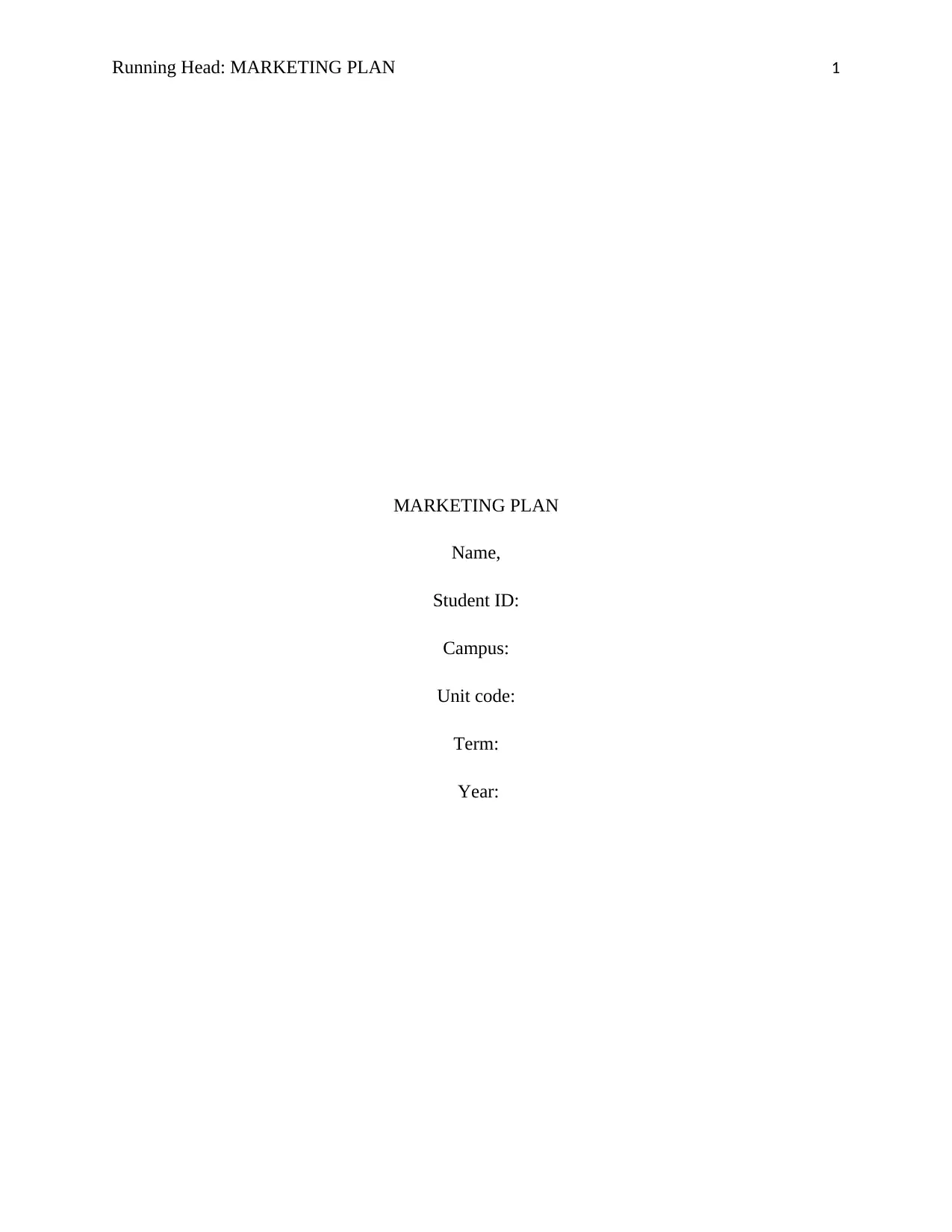
Running Head: MARKETING PLAN 1
MARKETING PLAN
Name,
Student ID:
Campus:
Unit code:
Term:
Year:
MARKETING PLAN
Name,
Student ID:
Campus:
Unit code:
Term:
Year:
Paraphrase This Document
Need a fresh take? Get an instant paraphrase of this document with our AI Paraphraser
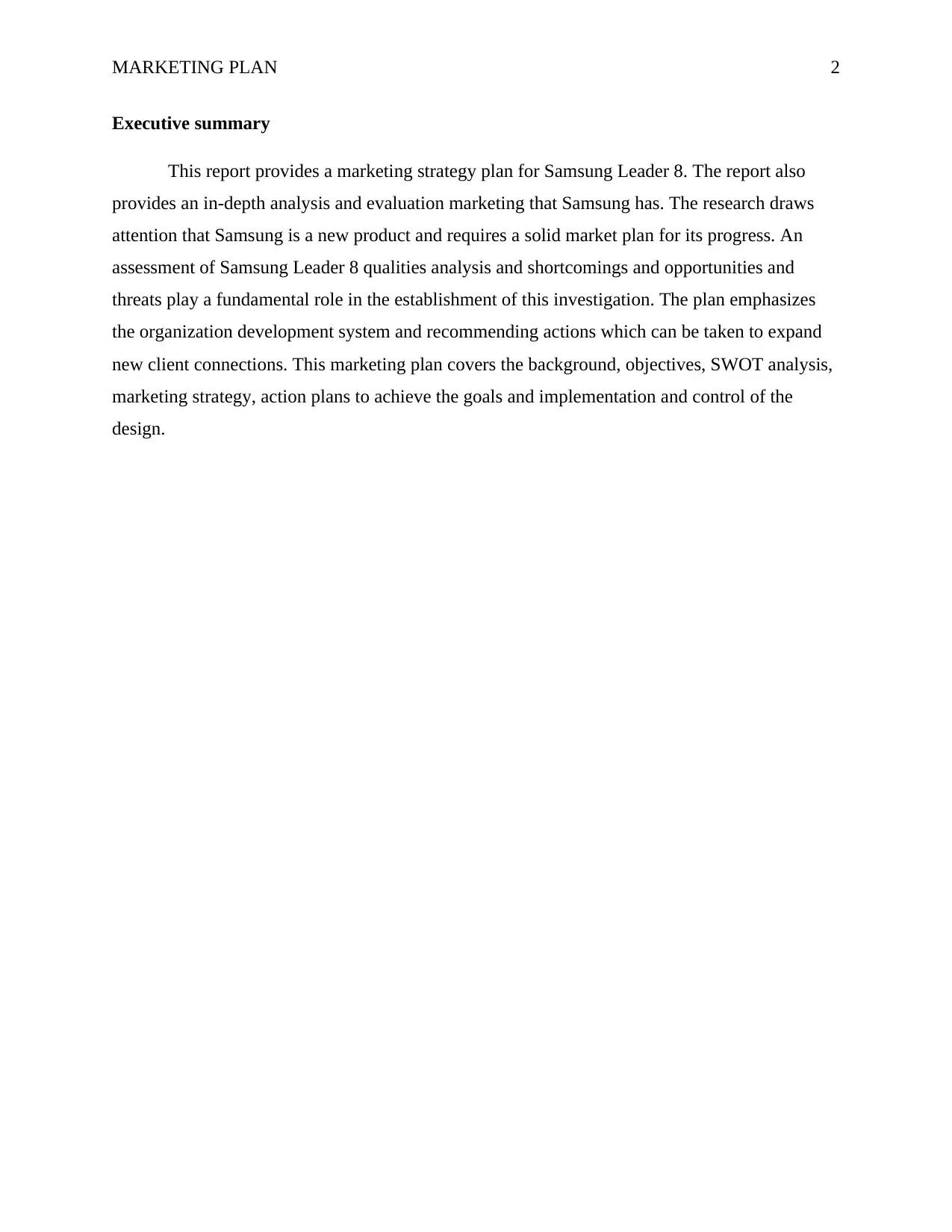
MARKETING PLAN 2
Executive summary
This report provides a marketing strategy plan for Samsung Leader 8. The report also
provides an in-depth analysis and evaluation marketing that Samsung has. The research draws
attention that Samsung is a new product and requires a solid market plan for its progress. An
assessment of Samsung Leader 8 qualities analysis and shortcomings and opportunities and
threats play a fundamental role in the establishment of this investigation. The plan emphasizes
the organization development system and recommending actions which can be taken to expand
new client connections. This marketing plan covers the background, objectives, SWOT analysis,
marketing strategy, action plans to achieve the goals and implementation and control of the
design.
Executive summary
This report provides a marketing strategy plan for Samsung Leader 8. The report also
provides an in-depth analysis and evaluation marketing that Samsung has. The research draws
attention that Samsung is a new product and requires a solid market plan for its progress. An
assessment of Samsung Leader 8 qualities analysis and shortcomings and opportunities and
threats play a fundamental role in the establishment of this investigation. The plan emphasizes
the organization development system and recommending actions which can be taken to expand
new client connections. This marketing plan covers the background, objectives, SWOT analysis,
marketing strategy, action plans to achieve the goals and implementation and control of the
design.
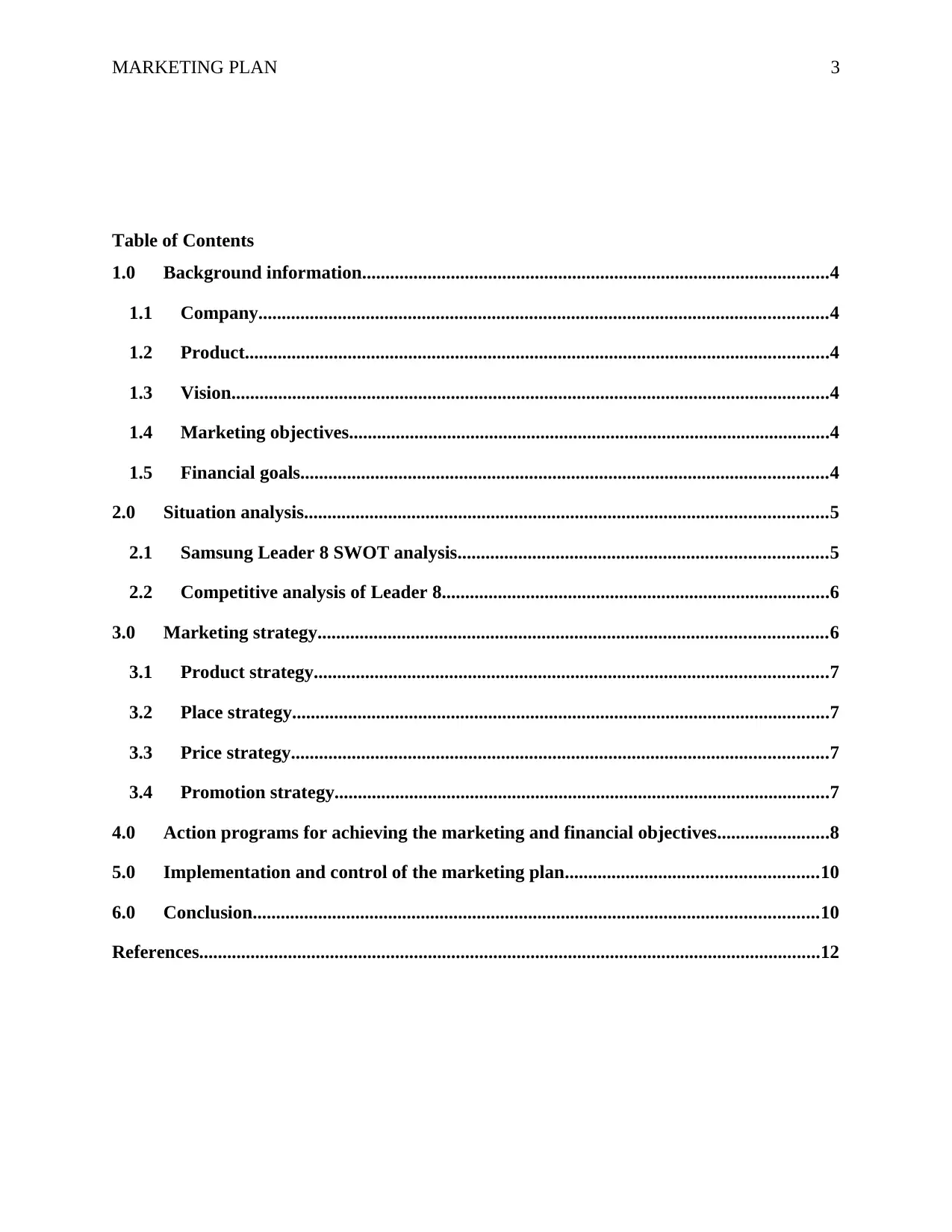
MARKETING PLAN 3
Table of Contents
1.0 Background information....................................................................................................4
1.1 Company..........................................................................................................................4
1.2 Product.............................................................................................................................4
1.3 Vision................................................................................................................................4
1.4 Marketing objectives.......................................................................................................4
1.5 Financial goals.................................................................................................................4
2.0 Situation analysis................................................................................................................5
2.1 Samsung Leader 8 SWOT analysis...............................................................................5
2.2 Competitive analysis of Leader 8...................................................................................6
3.0 Marketing strategy.............................................................................................................6
3.1 Product strategy..............................................................................................................7
3.2 Place strategy...................................................................................................................7
3.3 Price strategy...................................................................................................................7
3.4 Promotion strategy..........................................................................................................7
4.0 Action programs for achieving the marketing and financial objectives........................8
5.0 Implementation and control of the marketing plan......................................................10
6.0 Conclusion.........................................................................................................................10
References.....................................................................................................................................12
Table of Contents
1.0 Background information....................................................................................................4
1.1 Company..........................................................................................................................4
1.2 Product.............................................................................................................................4
1.3 Vision................................................................................................................................4
1.4 Marketing objectives.......................................................................................................4
1.5 Financial goals.................................................................................................................4
2.0 Situation analysis................................................................................................................5
2.1 Samsung Leader 8 SWOT analysis...............................................................................5
2.2 Competitive analysis of Leader 8...................................................................................6
3.0 Marketing strategy.............................................................................................................6
3.1 Product strategy..............................................................................................................7
3.2 Place strategy...................................................................................................................7
3.3 Price strategy...................................................................................................................7
3.4 Promotion strategy..........................................................................................................7
4.0 Action programs for achieving the marketing and financial objectives........................8
5.0 Implementation and control of the marketing plan......................................................10
6.0 Conclusion.........................................................................................................................10
References.....................................................................................................................................12
⊘ This is a preview!⊘
Do you want full access?
Subscribe today to unlock all pages.

Trusted by 1+ million students worldwide
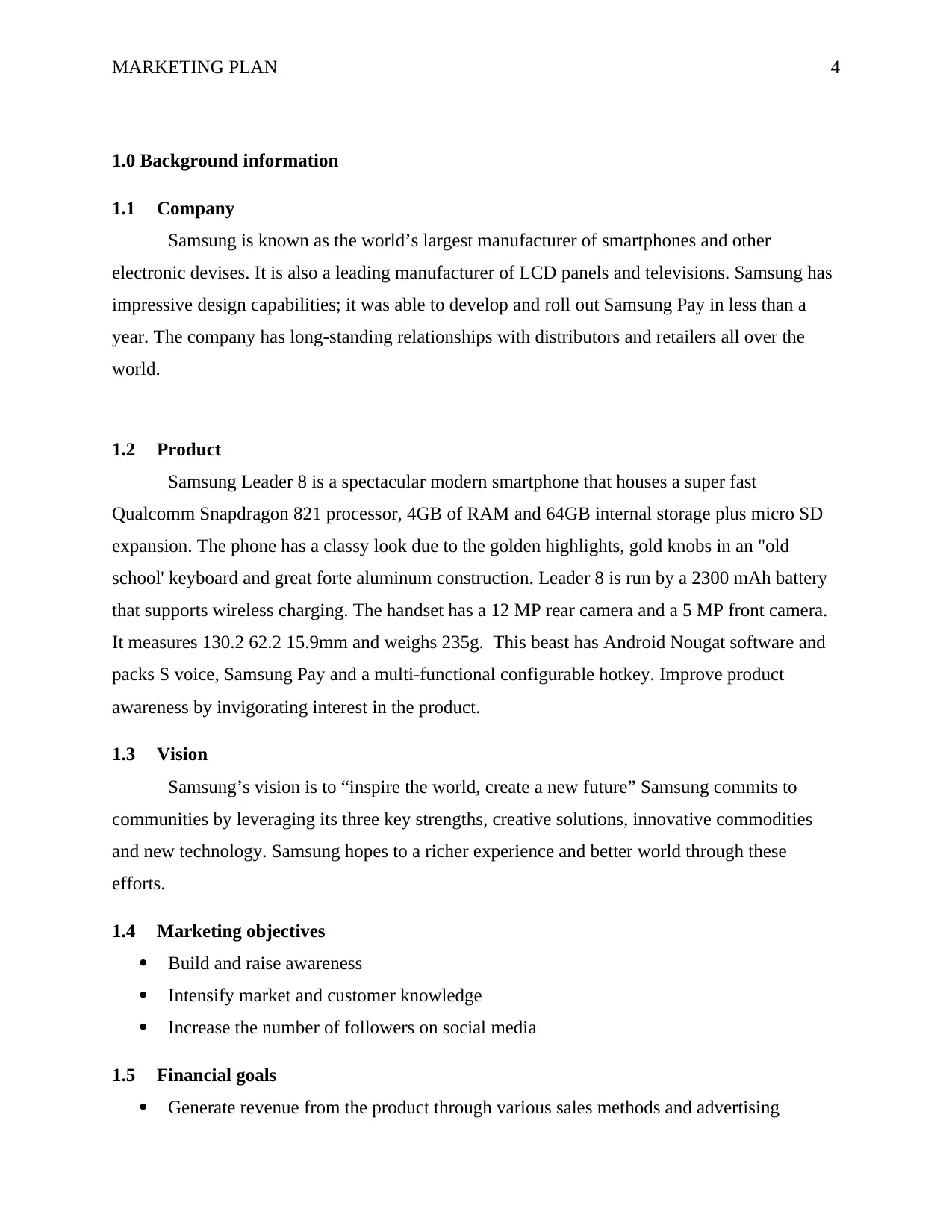
MARKETING PLAN 4
1.0 Background information
1.1 Company
Samsung is known as the world’s largest manufacturer of smartphones and other
electronic devises. It is also a leading manufacturer of LCD panels and televisions. Samsung has
impressive design capabilities; it was able to develop and roll out Samsung Pay in less than a
year. The company has long-standing relationships with distributors and retailers all over the
world.
1.2 Product
Samsung Leader 8 is a spectacular modern smartphone that houses a super fast
Qualcomm Snapdragon 821 processor, 4GB of RAM and 64GB internal storage plus micro SD
expansion. The phone has a classy look due to the golden highlights, gold knobs in an "old
school' keyboard and great forte aluminum construction. Leader 8 is run by a 2300 mAh battery
that supports wireless charging. The handset has a 12 MP rear camera and a 5 MP front camera.
It measures 130.2 62.2 15.9mm and weighs 235g. This beast has Android Nougat software and
packs S voice, Samsung Pay and a multi-functional configurable hotkey. Improve product
awareness by invigorating interest in the product.
1.3 Vision
Samsung’s vision is to “inspire the world, create a new future” Samsung commits to
communities by leveraging its three key strengths, creative solutions, innovative commodities
and new technology. Samsung hopes to a richer experience and better world through these
efforts.
1.4 Marketing objectives
Build and raise awareness
Intensify market and customer knowledge
Increase the number of followers on social media
1.5 Financial goals
Generate revenue from the product through various sales methods and advertising
1.0 Background information
1.1 Company
Samsung is known as the world’s largest manufacturer of smartphones and other
electronic devises. It is also a leading manufacturer of LCD panels and televisions. Samsung has
impressive design capabilities; it was able to develop and roll out Samsung Pay in less than a
year. The company has long-standing relationships with distributors and retailers all over the
world.
1.2 Product
Samsung Leader 8 is a spectacular modern smartphone that houses a super fast
Qualcomm Snapdragon 821 processor, 4GB of RAM and 64GB internal storage plus micro SD
expansion. The phone has a classy look due to the golden highlights, gold knobs in an "old
school' keyboard and great forte aluminum construction. Leader 8 is run by a 2300 mAh battery
that supports wireless charging. The handset has a 12 MP rear camera and a 5 MP front camera.
It measures 130.2 62.2 15.9mm and weighs 235g. This beast has Android Nougat software and
packs S voice, Samsung Pay and a multi-functional configurable hotkey. Improve product
awareness by invigorating interest in the product.
1.3 Vision
Samsung’s vision is to “inspire the world, create a new future” Samsung commits to
communities by leveraging its three key strengths, creative solutions, innovative commodities
and new technology. Samsung hopes to a richer experience and better world through these
efforts.
1.4 Marketing objectives
Build and raise awareness
Intensify market and customer knowledge
Increase the number of followers on social media
1.5 Financial goals
Generate revenue from the product through various sales methods and advertising
Paraphrase This Document
Need a fresh take? Get an instant paraphrase of this document with our AI Paraphraser
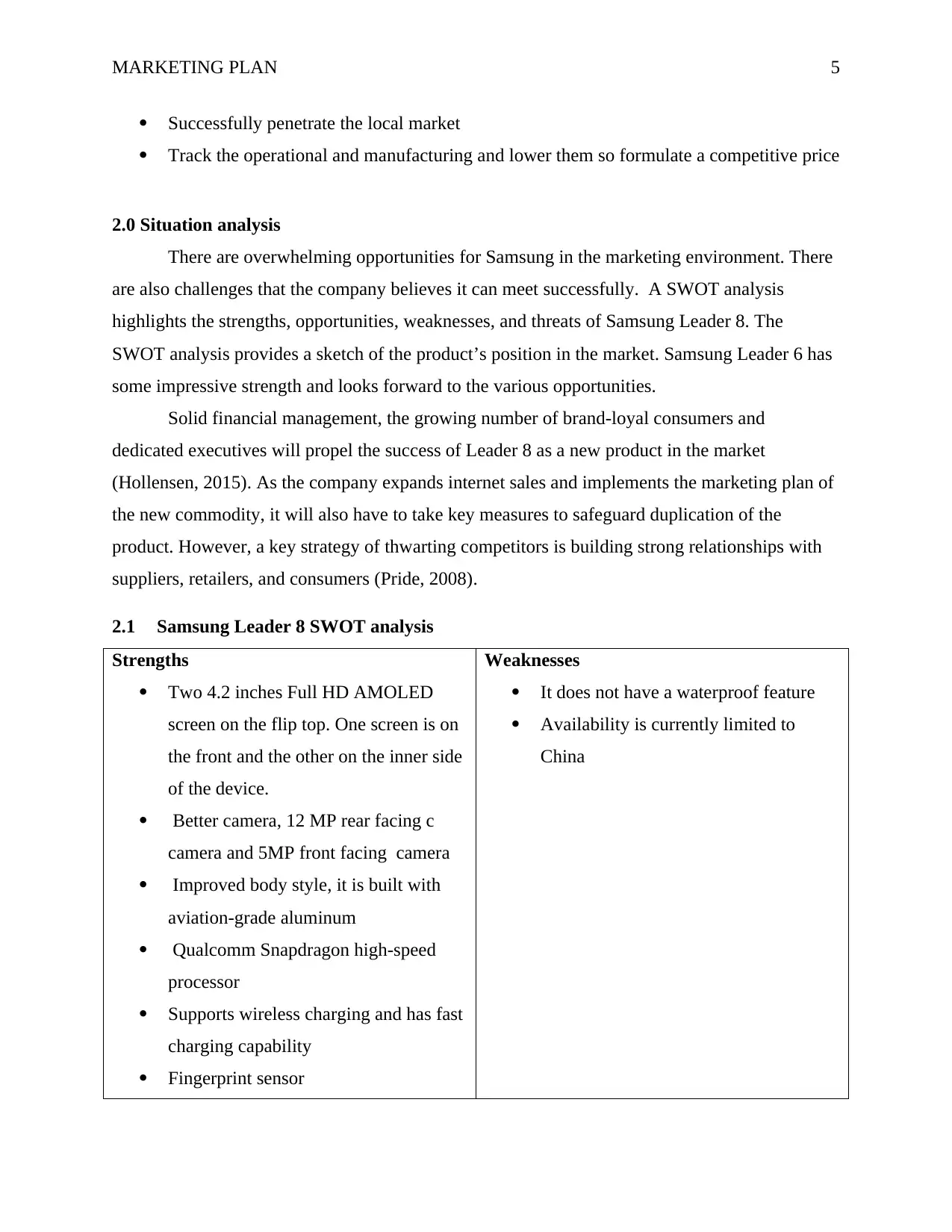
MARKETING PLAN 5
Successfully penetrate the local market
Track the operational and manufacturing and lower them so formulate a competitive price
2.0 Situation analysis
There are overwhelming opportunities for Samsung in the marketing environment. There
are also challenges that the company believes it can meet successfully. A SWOT analysis
highlights the strengths, opportunities, weaknesses, and threats of Samsung Leader 8. The
SWOT analysis provides a sketch of the product’s position in the market. Samsung Leader 6 has
some impressive strength and looks forward to the various opportunities.
Solid financial management, the growing number of brand-loyal consumers and
dedicated executives will propel the success of Leader 8 as a new product in the market
(Hollensen, 2015). As the company expands internet sales and implements the marketing plan of
the new commodity, it will also have to take key measures to safeguard duplication of the
product. However, a key strategy of thwarting competitors is building strong relationships with
suppliers, retailers, and consumers (Pride, 2008).
2.1 Samsung Leader 8 SWOT analysis
Strengths
Two 4.2 inches Full HD AMOLED
screen on the flip top. One screen is on
the front and the other on the inner side
of the device.
Better camera, 12 MP rear facing c
camera and 5MP front facing camera
Improved body style, it is built with
aviation-grade aluminum
Qualcomm Snapdragon high-speed
processor
Supports wireless charging and has fast
charging capability
Fingerprint sensor
Weaknesses
It does not have a waterproof feature
Availability is currently limited to
China
Successfully penetrate the local market
Track the operational and manufacturing and lower them so formulate a competitive price
2.0 Situation analysis
There are overwhelming opportunities for Samsung in the marketing environment. There
are also challenges that the company believes it can meet successfully. A SWOT analysis
highlights the strengths, opportunities, weaknesses, and threats of Samsung Leader 8. The
SWOT analysis provides a sketch of the product’s position in the market. Samsung Leader 6 has
some impressive strength and looks forward to the various opportunities.
Solid financial management, the growing number of brand-loyal consumers and
dedicated executives will propel the success of Leader 8 as a new product in the market
(Hollensen, 2015). As the company expands internet sales and implements the marketing plan of
the new commodity, it will also have to take key measures to safeguard duplication of the
product. However, a key strategy of thwarting competitors is building strong relationships with
suppliers, retailers, and consumers (Pride, 2008).
2.1 Samsung Leader 8 SWOT analysis
Strengths
Two 4.2 inches Full HD AMOLED
screen on the flip top. One screen is on
the front and the other on the inner side
of the device.
Better camera, 12 MP rear facing c
camera and 5MP front facing camera
Improved body style, it is built with
aviation-grade aluminum
Qualcomm Snapdragon high-speed
processor
Supports wireless charging and has fast
charging capability
Fingerprint sensor
Weaknesses
It does not have a waterproof feature
Availability is currently limited to
China

MARKETING PLAN 6
Opportunities
Improve on the brand with regular
updates
Better processors available on other
Samsung phones
Samsung can export the product to
other countries thus expanding its
turnover and edges exponentially.
Enormous total market potential
Increasingly growing online market
Samsung’s loyal customers are likely to
buy the new product
Threats
The major threat for Samsung Leader 8
is the competition especially from other
companies planning to launch flip
phones.
The mobile phones market has intense
price competition
Internal competition regarding internet
sales may lead to the deterioration of
the enterprise's relationship with
retailers
2.2 Competitive analysis of Leader 8
The competitive scenario regarding the IT and technology industry is significant as each
IT and technology operator is competing against each other with a view of acquiring market
shares of the others. An analysis of the of the industry especially concerning flip phones
indicates that the most significant competitor is LG. These two IT and technology companies are
competing against each other and the competition is evident mainly in both companies planning
to launch flip phones this year.
The competitive scenario has been awful, and this has caused a significant drop in the
number of shipments. The industry competition is not good, as most Western consumers do not
prefer flip phones and at the same time, the highly competitive market environment is highly
affecting the IT and technology industry significantly.
Opportunities
Improve on the brand with regular
updates
Better processors available on other
Samsung phones
Samsung can export the product to
other countries thus expanding its
turnover and edges exponentially.
Enormous total market potential
Increasingly growing online market
Samsung’s loyal customers are likely to
buy the new product
Threats
The major threat for Samsung Leader 8
is the competition especially from other
companies planning to launch flip
phones.
The mobile phones market has intense
price competition
Internal competition regarding internet
sales may lead to the deterioration of
the enterprise's relationship with
retailers
2.2 Competitive analysis of Leader 8
The competitive scenario regarding the IT and technology industry is significant as each
IT and technology operator is competing against each other with a view of acquiring market
shares of the others. An analysis of the of the industry especially concerning flip phones
indicates that the most significant competitor is LG. These two IT and technology companies are
competing against each other and the competition is evident mainly in both companies planning
to launch flip phones this year.
The competitive scenario has been awful, and this has caused a significant drop in the
number of shipments. The industry competition is not good, as most Western consumers do not
prefer flip phones and at the same time, the highly competitive market environment is highly
affecting the IT and technology industry significantly.
⊘ This is a preview!⊘
Do you want full access?
Subscribe today to unlock all pages.

Trusted by 1+ million students worldwide
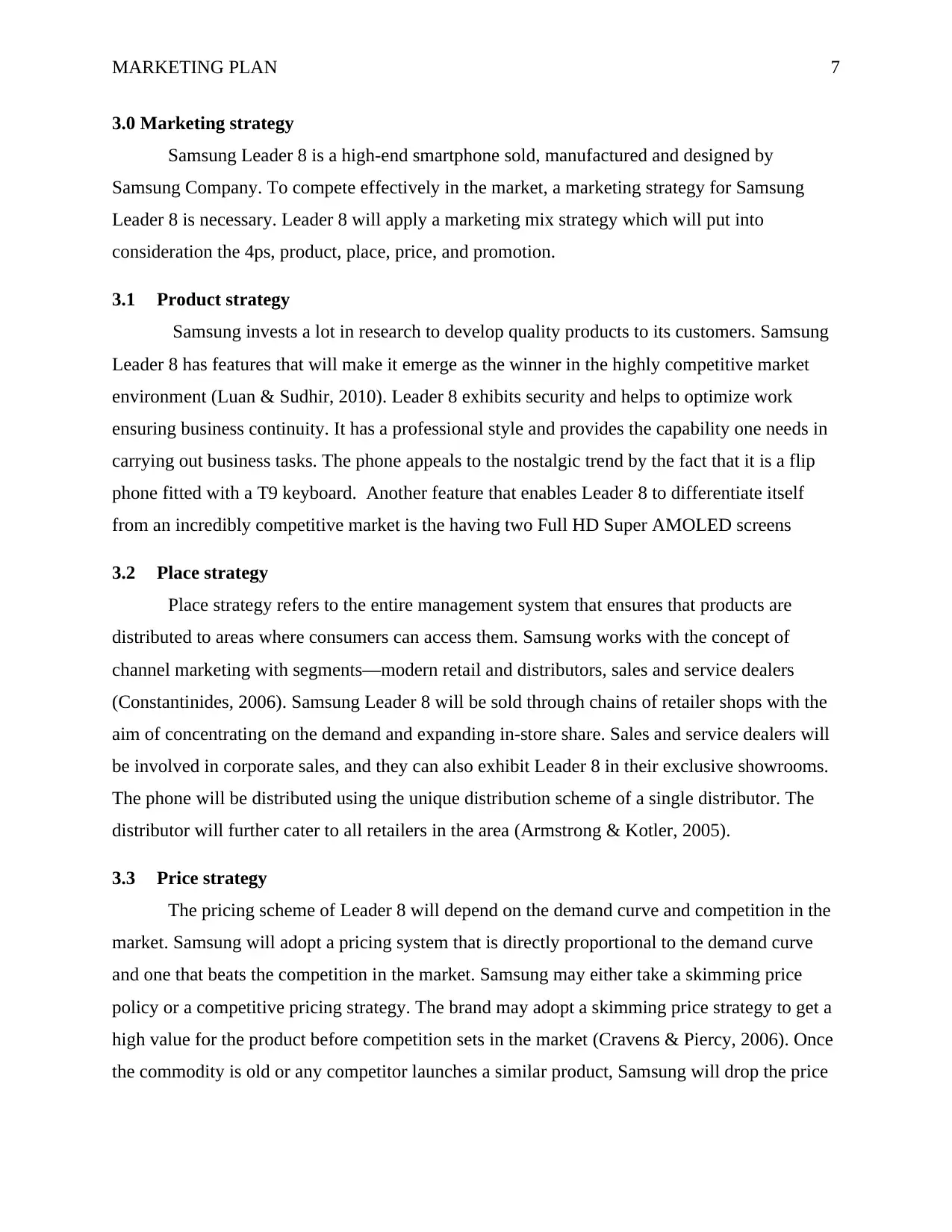
MARKETING PLAN 7
3.0 Marketing strategy
Samsung Leader 8 is a high-end smartphone sold, manufactured and designed by
Samsung Company. To compete effectively in the market, a marketing strategy for Samsung
Leader 8 is necessary. Leader 8 will apply a marketing mix strategy which will put into
consideration the 4ps, product, place, price, and promotion.
3.1 Product strategy
Samsung invests a lot in research to develop quality products to its customers. Samsung
Leader 8 has features that will make it emerge as the winner in the highly competitive market
environment (Luan & Sudhir, 2010). Leader 8 exhibits security and helps to optimize work
ensuring business continuity. It has a professional style and provides the capability one needs in
carrying out business tasks. The phone appeals to the nostalgic trend by the fact that it is a flip
phone fitted with a T9 keyboard. Another feature that enables Leader 8 to differentiate itself
from an incredibly competitive market is the having two Full HD Super AMOLED screens
3.2 Place strategy
Place strategy refers to the entire management system that ensures that products are
distributed to areas where consumers can access them. Samsung works with the concept of
channel marketing with segments—modern retail and distributors, sales and service dealers
(Constantinides, 2006). Samsung Leader 8 will be sold through chains of retailer shops with the
aim of concentrating on the demand and expanding in-store share. Sales and service dealers will
be involved in corporate sales, and they can also exhibit Leader 8 in their exclusive showrooms.
The phone will be distributed using the unique distribution scheme of a single distributor. The
distributor will further cater to all retailers in the area (Armstrong & Kotler, 2005).
3.3 Price strategy
The pricing scheme of Leader 8 will depend on the demand curve and competition in the
market. Samsung will adopt a pricing system that is directly proportional to the demand curve
and one that beats the competition in the market. Samsung may either take a skimming price
policy or a competitive pricing strategy. The brand may adopt a skimming price strategy to get a
high value for the product before competition sets in the market (Cravens & Piercy, 2006). Once
the commodity is old or any competitor launches a similar product, Samsung will drop the price
3.0 Marketing strategy
Samsung Leader 8 is a high-end smartphone sold, manufactured and designed by
Samsung Company. To compete effectively in the market, a marketing strategy for Samsung
Leader 8 is necessary. Leader 8 will apply a marketing mix strategy which will put into
consideration the 4ps, product, place, price, and promotion.
3.1 Product strategy
Samsung invests a lot in research to develop quality products to its customers. Samsung
Leader 8 has features that will make it emerge as the winner in the highly competitive market
environment (Luan & Sudhir, 2010). Leader 8 exhibits security and helps to optimize work
ensuring business continuity. It has a professional style and provides the capability one needs in
carrying out business tasks. The phone appeals to the nostalgic trend by the fact that it is a flip
phone fitted with a T9 keyboard. Another feature that enables Leader 8 to differentiate itself
from an incredibly competitive market is the having two Full HD Super AMOLED screens
3.2 Place strategy
Place strategy refers to the entire management system that ensures that products are
distributed to areas where consumers can access them. Samsung works with the concept of
channel marketing with segments—modern retail and distributors, sales and service dealers
(Constantinides, 2006). Samsung Leader 8 will be sold through chains of retailer shops with the
aim of concentrating on the demand and expanding in-store share. Sales and service dealers will
be involved in corporate sales, and they can also exhibit Leader 8 in their exclusive showrooms.
The phone will be distributed using the unique distribution scheme of a single distributor. The
distributor will further cater to all retailers in the area (Armstrong & Kotler, 2005).
3.3 Price strategy
The pricing scheme of Leader 8 will depend on the demand curve and competition in the
market. Samsung will adopt a pricing system that is directly proportional to the demand curve
and one that beats the competition in the market. Samsung may either take a skimming price
policy or a competitive pricing strategy. The brand may adopt a skimming price strategy to get a
high value for the product before competition sets in the market (Cravens & Piercy, 2006). Once
the commodity is old or any competitor launches a similar product, Samsung will drop the price
Paraphrase This Document
Need a fresh take? Get an instant paraphrase of this document with our AI Paraphraser
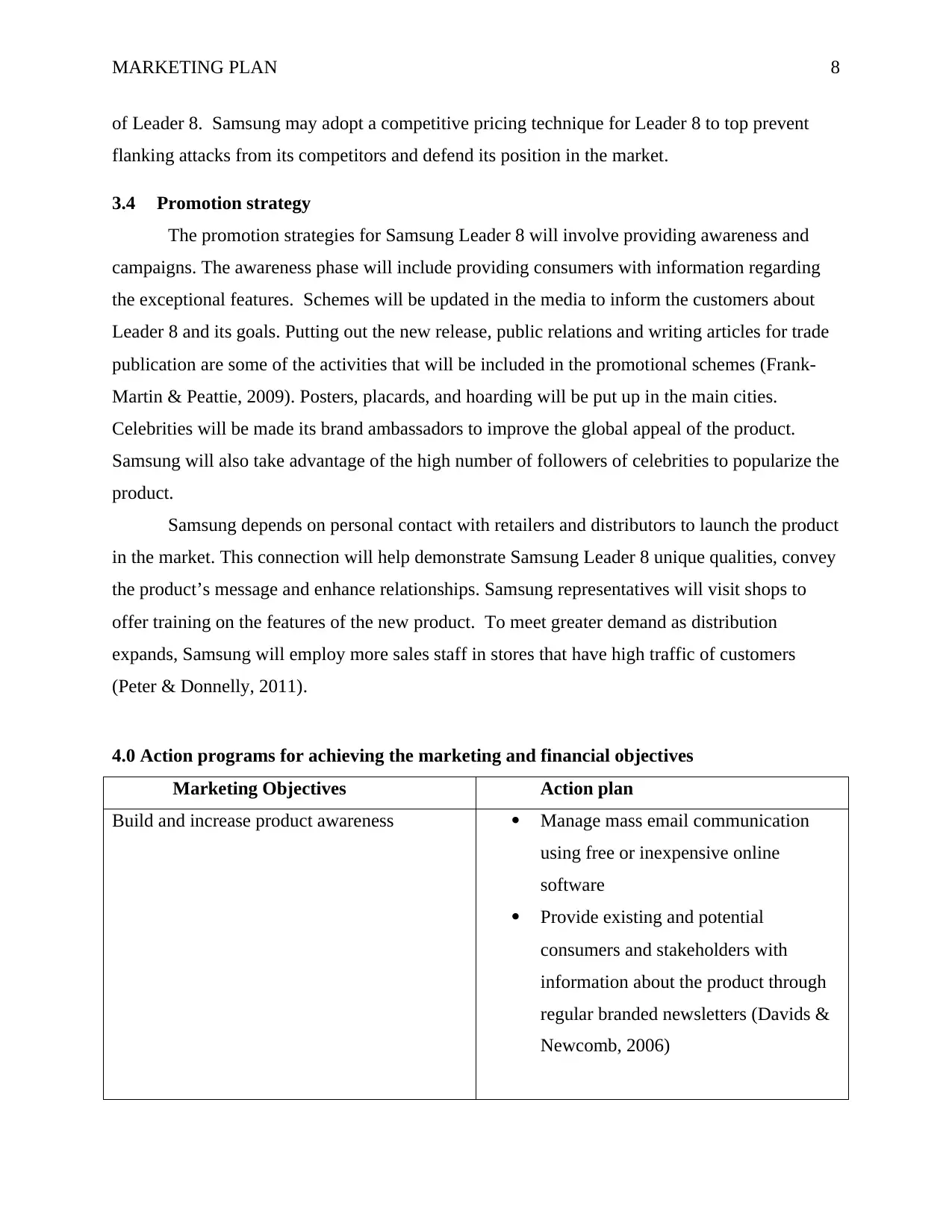
MARKETING PLAN 8
of Leader 8. Samsung may adopt a competitive pricing technique for Leader 8 to top prevent
flanking attacks from its competitors and defend its position in the market.
3.4 Promotion strategy
The promotion strategies for Samsung Leader 8 will involve providing awareness and
campaigns. The awareness phase will include providing consumers with information regarding
the exceptional features. Schemes will be updated in the media to inform the customers about
Leader 8 and its goals. Putting out the new release, public relations and writing articles for trade
publication are some of the activities that will be included in the promotional schemes (Frank-
Martin & Peattie, 2009). Posters, placards, and hoarding will be put up in the main cities.
Celebrities will be made its brand ambassadors to improve the global appeal of the product.
Samsung will also take advantage of the high number of followers of celebrities to popularize the
product.
Samsung depends on personal contact with retailers and distributors to launch the product
in the market. This connection will help demonstrate Samsung Leader 8 unique qualities, convey
the product’s message and enhance relationships. Samsung representatives will visit shops to
offer training on the features of the new product. To meet greater demand as distribution
expands, Samsung will employ more sales staff in stores that have high traffic of customers
(Peter & Donnelly, 2011).
4.0 Action programs for achieving the marketing and financial objectives
Marketing Objectives Action plan
Build and increase product awareness Manage mass email communication
using free or inexpensive online
software
Provide existing and potential
consumers and stakeholders with
information about the product through
regular branded newsletters (Davids &
Newcomb, 2006)
of Leader 8. Samsung may adopt a competitive pricing technique for Leader 8 to top prevent
flanking attacks from its competitors and defend its position in the market.
3.4 Promotion strategy
The promotion strategies for Samsung Leader 8 will involve providing awareness and
campaigns. The awareness phase will include providing consumers with information regarding
the exceptional features. Schemes will be updated in the media to inform the customers about
Leader 8 and its goals. Putting out the new release, public relations and writing articles for trade
publication are some of the activities that will be included in the promotional schemes (Frank-
Martin & Peattie, 2009). Posters, placards, and hoarding will be put up in the main cities.
Celebrities will be made its brand ambassadors to improve the global appeal of the product.
Samsung will also take advantage of the high number of followers of celebrities to popularize the
product.
Samsung depends on personal contact with retailers and distributors to launch the product
in the market. This connection will help demonstrate Samsung Leader 8 unique qualities, convey
the product’s message and enhance relationships. Samsung representatives will visit shops to
offer training on the features of the new product. To meet greater demand as distribution
expands, Samsung will employ more sales staff in stores that have high traffic of customers
(Peter & Donnelly, 2011).
4.0 Action programs for achieving the marketing and financial objectives
Marketing Objectives Action plan
Build and increase product awareness Manage mass email communication
using free or inexpensive online
software
Provide existing and potential
consumers and stakeholders with
information about the product through
regular branded newsletters (Davids &
Newcomb, 2006)
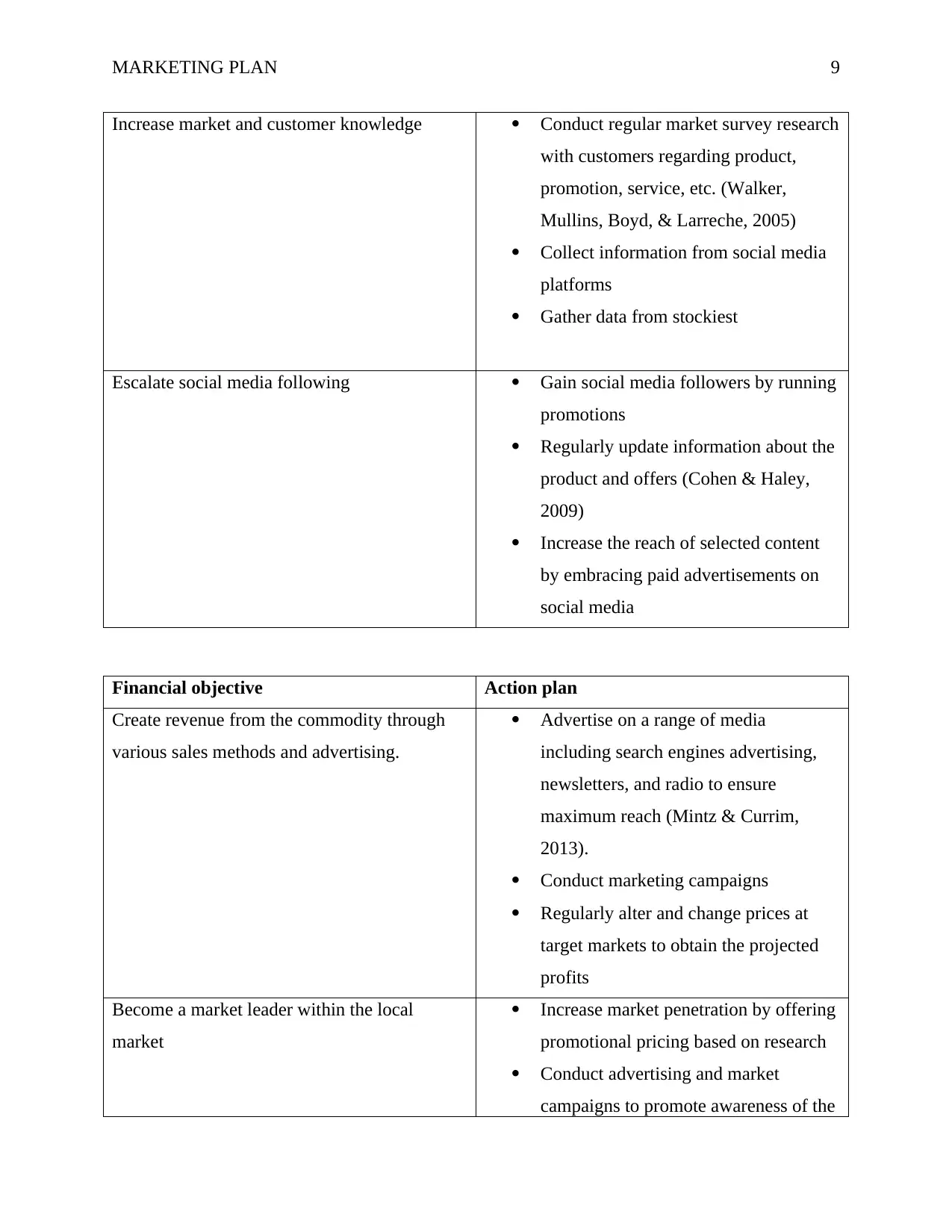
MARKETING PLAN 9
Increase market and customer knowledge Conduct regular market survey research
with customers regarding product,
promotion, service, etc. (Walker,
Mullins, Boyd, & Larreche, 2005)
Collect information from social media
platforms
Gather data from stockiest
Escalate social media following Gain social media followers by running
promotions
Regularly update information about the
product and offers (Cohen & Haley,
2009)
Increase the reach of selected content
by embracing paid advertisements on
social media
Financial objective Action plan
Create revenue from the commodity through
various sales methods and advertising.
Advertise on a range of media
including search engines advertising,
newsletters, and radio to ensure
maximum reach (Mintz & Currim,
2013).
Conduct marketing campaigns
Regularly alter and change prices at
target markets to obtain the projected
profits
Become a market leader within the local
market
Increase market penetration by offering
promotional pricing based on research
Conduct advertising and market
campaigns to promote awareness of the
Increase market and customer knowledge Conduct regular market survey research
with customers regarding product,
promotion, service, etc. (Walker,
Mullins, Boyd, & Larreche, 2005)
Collect information from social media
platforms
Gather data from stockiest
Escalate social media following Gain social media followers by running
promotions
Regularly update information about the
product and offers (Cohen & Haley,
2009)
Increase the reach of selected content
by embracing paid advertisements on
social media
Financial objective Action plan
Create revenue from the commodity through
various sales methods and advertising.
Advertise on a range of media
including search engines advertising,
newsletters, and radio to ensure
maximum reach (Mintz & Currim,
2013).
Conduct marketing campaigns
Regularly alter and change prices at
target markets to obtain the projected
profits
Become a market leader within the local
market
Increase market penetration by offering
promotional pricing based on research
Conduct advertising and market
campaigns to promote awareness of the
⊘ This is a preview!⊘
Do you want full access?
Subscribe today to unlock all pages.

Trusted by 1+ million students worldwide
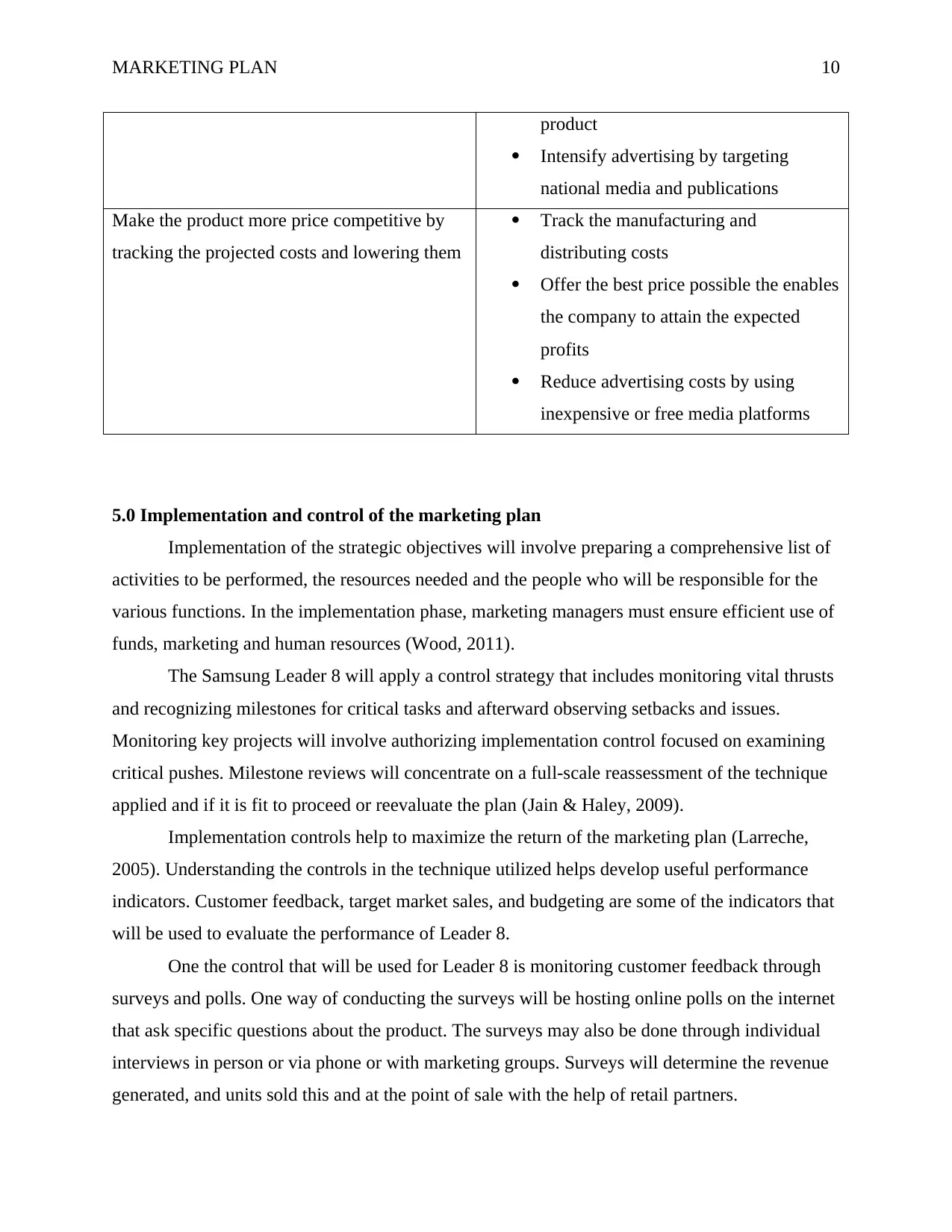
MARKETING PLAN 10
product
Intensify advertising by targeting
national media and publications
Make the product more price competitive by
tracking the projected costs and lowering them
Track the manufacturing and
distributing costs
Offer the best price possible the enables
the company to attain the expected
profits
Reduce advertising costs by using
inexpensive or free media platforms
5.0 Implementation and control of the marketing plan
Implementation of the strategic objectives will involve preparing a comprehensive list of
activities to be performed, the resources needed and the people who will be responsible for the
various functions. In the implementation phase, marketing managers must ensure efficient use of
funds, marketing and human resources (Wood, 2011).
The Samsung Leader 8 will apply a control strategy that includes monitoring vital thrusts
and recognizing milestones for critical tasks and afterward observing setbacks and issues.
Monitoring key projects will involve authorizing implementation control focused on examining
critical pushes. Milestone reviews will concentrate on a full-scale reassessment of the technique
applied and if it is fit to proceed or reevaluate the plan (Jain & Haley, 2009).
Implementation controls help to maximize the return of the marketing plan (Larreche,
2005). Understanding the controls in the technique utilized helps develop useful performance
indicators. Customer feedback, target market sales, and budgeting are some of the indicators that
will be used to evaluate the performance of Leader 8.
One the control that will be used for Leader 8 is monitoring customer feedback through
surveys and polls. One way of conducting the surveys will be hosting online polls on the internet
that ask specific questions about the product. The surveys may also be done through individual
interviews in person or via phone or with marketing groups. Surveys will determine the revenue
generated, and units sold this and at the point of sale with the help of retail partners.
product
Intensify advertising by targeting
national media and publications
Make the product more price competitive by
tracking the projected costs and lowering them
Track the manufacturing and
distributing costs
Offer the best price possible the enables
the company to attain the expected
profits
Reduce advertising costs by using
inexpensive or free media platforms
5.0 Implementation and control of the marketing plan
Implementation of the strategic objectives will involve preparing a comprehensive list of
activities to be performed, the resources needed and the people who will be responsible for the
various functions. In the implementation phase, marketing managers must ensure efficient use of
funds, marketing and human resources (Wood, 2011).
The Samsung Leader 8 will apply a control strategy that includes monitoring vital thrusts
and recognizing milestones for critical tasks and afterward observing setbacks and issues.
Monitoring key projects will involve authorizing implementation control focused on examining
critical pushes. Milestone reviews will concentrate on a full-scale reassessment of the technique
applied and if it is fit to proceed or reevaluate the plan (Jain & Haley, 2009).
Implementation controls help to maximize the return of the marketing plan (Larreche,
2005). Understanding the controls in the technique utilized helps develop useful performance
indicators. Customer feedback, target market sales, and budgeting are some of the indicators that
will be used to evaluate the performance of Leader 8.
One the control that will be used for Leader 8 is monitoring customer feedback through
surveys and polls. One way of conducting the surveys will be hosting online polls on the internet
that ask specific questions about the product. The surveys may also be done through individual
interviews in person or via phone or with marketing groups. Surveys will determine the revenue
generated, and units sold this and at the point of sale with the help of retail partners.
Paraphrase This Document
Need a fresh take? Get an instant paraphrase of this document with our AI Paraphraser
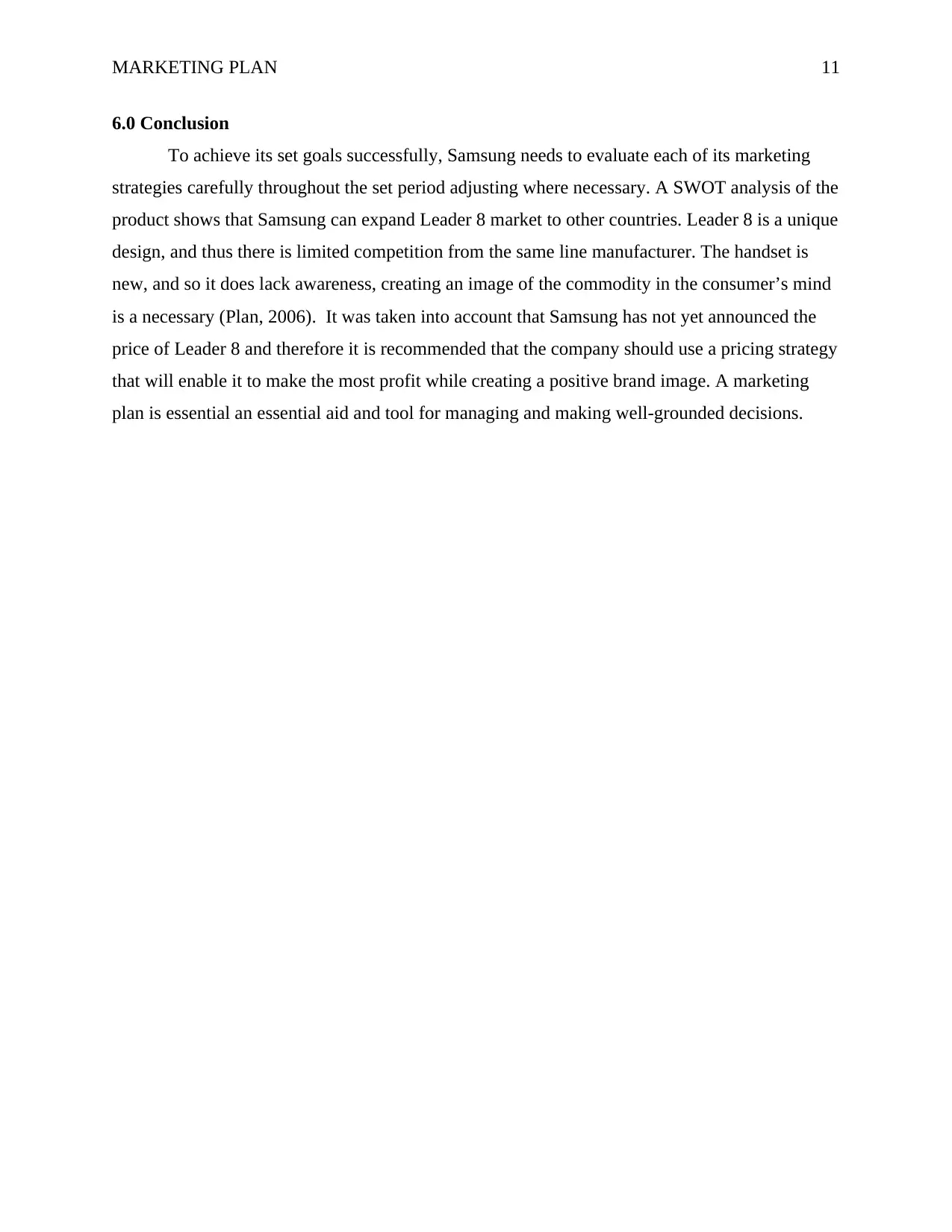
MARKETING PLAN 11
6.0 Conclusion
To achieve its set goals successfully, Samsung needs to evaluate each of its marketing
strategies carefully throughout the set period adjusting where necessary. A SWOT analysis of the
product shows that Samsung can expand Leader 8 market to other countries. Leader 8 is a unique
design, and thus there is limited competition from the same line manufacturer. The handset is
new, and so it does lack awareness, creating an image of the commodity in the consumer’s mind
is a necessary (Plan, 2006). It was taken into account that Samsung has not yet announced the
price of Leader 8 and therefore it is recommended that the company should use a pricing strategy
that will enable it to make the most profit while creating a positive brand image. A marketing
plan is essential an essential aid and tool for managing and making well-grounded decisions.
6.0 Conclusion
To achieve its set goals successfully, Samsung needs to evaluate each of its marketing
strategies carefully throughout the set period adjusting where necessary. A SWOT analysis of the
product shows that Samsung can expand Leader 8 market to other countries. Leader 8 is a unique
design, and thus there is limited competition from the same line manufacturer. The handset is
new, and so it does lack awareness, creating an image of the commodity in the consumer’s mind
is a necessary (Plan, 2006). It was taken into account that Samsung has not yet announced the
price of Leader 8 and therefore it is recommended that the company should use a pricing strategy
that will enable it to make the most profit while creating a positive brand image. A marketing
plan is essential an essential aid and tool for managing and making well-grounded decisions.
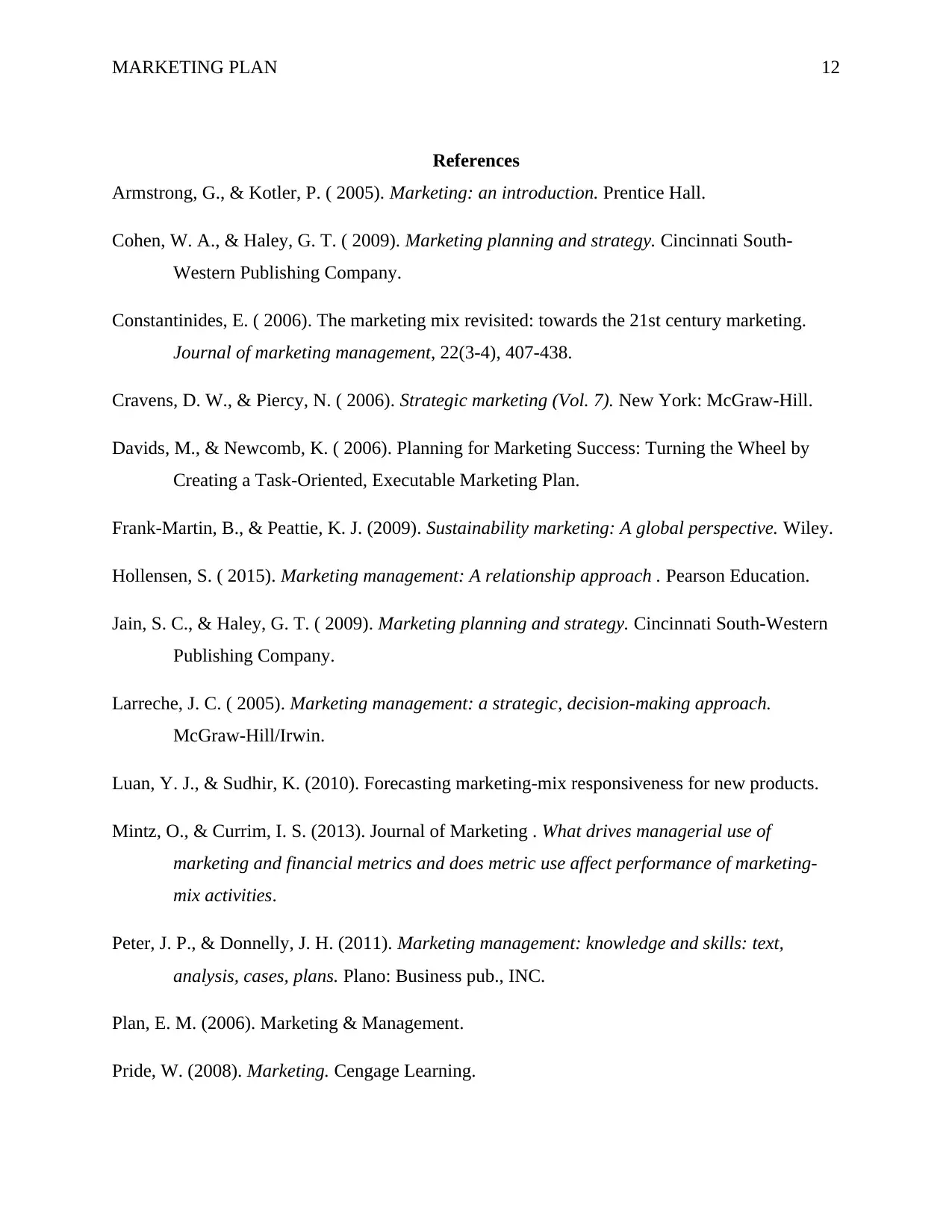
MARKETING PLAN 12
References
Armstrong, G., & Kotler, P. ( 2005). Marketing: an introduction. Prentice Hall.
Cohen, W. A., & Haley, G. T. ( 2009). Marketing planning and strategy. Cincinnati South-
Western Publishing Company.
Constantinides, E. ( 2006). The marketing mix revisited: towards the 21st century marketing.
Journal of marketing management, 22(3-4), 407-438.
Cravens, D. W., & Piercy, N. ( 2006). Strategic marketing (Vol. 7). New York: McGraw-Hill.
Davids, M., & Newcomb, K. ( 2006). Planning for Marketing Success: Turning the Wheel by
Creating a Task-Oriented, Executable Marketing Plan.
Frank-Martin, B., & Peattie, K. J. (2009). Sustainability marketing: A global perspective. Wiley.
Hollensen, S. ( 2015). Marketing management: A relationship approach . Pearson Education.
Jain, S. C., & Haley, G. T. ( 2009). Marketing planning and strategy. Cincinnati South-Western
Publishing Company.
Larreche, J. C. ( 2005). Marketing management: a strategic, decision-making approach.
McGraw-Hill/Irwin.
Luan, Y. J., & Sudhir, K. (2010). Forecasting marketing-mix responsiveness for new products.
Mintz, O., & Currim, I. S. (2013). Journal of Marketing . What drives managerial use of
marketing and financial metrics and does metric use affect performance of marketing-
mix activities.
Peter, J. P., & Donnelly, J. H. (2011). Marketing management: knowledge and skills: text,
analysis, cases, plans. Plano: Business pub., INC.
Plan, E. M. (2006). Marketing & Management.
Pride, W. (2008). Marketing. Cengage Learning.
References
Armstrong, G., & Kotler, P. ( 2005). Marketing: an introduction. Prentice Hall.
Cohen, W. A., & Haley, G. T. ( 2009). Marketing planning and strategy. Cincinnati South-
Western Publishing Company.
Constantinides, E. ( 2006). The marketing mix revisited: towards the 21st century marketing.
Journal of marketing management, 22(3-4), 407-438.
Cravens, D. W., & Piercy, N. ( 2006). Strategic marketing (Vol. 7). New York: McGraw-Hill.
Davids, M., & Newcomb, K. ( 2006). Planning for Marketing Success: Turning the Wheel by
Creating a Task-Oriented, Executable Marketing Plan.
Frank-Martin, B., & Peattie, K. J. (2009). Sustainability marketing: A global perspective. Wiley.
Hollensen, S. ( 2015). Marketing management: A relationship approach . Pearson Education.
Jain, S. C., & Haley, G. T. ( 2009). Marketing planning and strategy. Cincinnati South-Western
Publishing Company.
Larreche, J. C. ( 2005). Marketing management: a strategic, decision-making approach.
McGraw-Hill/Irwin.
Luan, Y. J., & Sudhir, K. (2010). Forecasting marketing-mix responsiveness for new products.
Mintz, O., & Currim, I. S. (2013). Journal of Marketing . What drives managerial use of
marketing and financial metrics and does metric use affect performance of marketing-
mix activities.
Peter, J. P., & Donnelly, J. H. (2011). Marketing management: knowledge and skills: text,
analysis, cases, plans. Plano: Business pub., INC.
Plan, E. M. (2006). Marketing & Management.
Pride, W. (2008). Marketing. Cengage Learning.
⊘ This is a preview!⊘
Do you want full access?
Subscribe today to unlock all pages.

Trusted by 1+ million students worldwide
1 out of 13
Related Documents
Your All-in-One AI-Powered Toolkit for Academic Success.
+13062052269
info@desklib.com
Available 24*7 on WhatsApp / Email
![[object Object]](/_next/static/media/star-bottom.7253800d.svg)
Unlock your academic potential
Copyright © 2020–2025 A2Z Services. All Rights Reserved. Developed and managed by ZUCOL.





